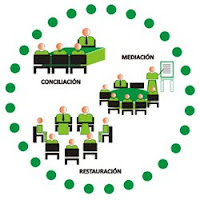Throughout the entire country of Mexico, states are designing and implementing completely new criminal processes in response to an amendment of the national Constitution in 2006. Within the adult criminal justice system, criminal defendants have the right to oral trials for the first time in the country’s history. Along with the right to oral trials come accompanying due process rights, such as a presumption of innocence, the right to counsel, the right to remain silent, the right to a speedy trial, and the requirement that the government prove a defendant’s guilt beyond a reasonable doubt. Many of these reforms are similar to the American legal system. One major difference is that in Mexico, there is no right to a jury trial. Guilt or innocence is determined by a panel of 3 judges instead.
Each state is responsible for modifying its own penal code, in accordance with the general standards set forth in the national Constitutional amendment. Juvenile justice processes are an important component of this reform. Until now, many states operated juvenile delinquency proceedings as an administrative process with no due process rights or procedural safeguards. The Constitutional reform requires each state to develop juvenile delinquency procedures that incorporate the same rights and protections afforded to adults. This is a major change.
In response to the Constitutional mandate, the state of Oaxaca began to develop a juvenile justice system three years ago. Starting from scratch, they turned to other countries to learn about successful models for juvenile courts. They learned that particularly within the context of juvenile courts, most cases do not go to trial, but rather resolve through alternative processes. In designing their system, the state of Oaxaca wrote restorative justice processes into their juvenile justice procedural laws.
The great majority of juvenile delinquency cases in Oaxaca are resolved through restorative justice meetings that bring together the victim, offender, and their respective family members in order to develop appropriate sanctions for the offender and appropriate reparations for the victim. Psychologists and attorneys who work at the state’s Center for Restorative Justice do a great deal of preparation with the offenders, victims, and respective family members prior to facilitating the meeting that brings the parties together. They have had quite a bit of success with this model, and have resolved serious cases including shootings and manslaughter through restorative justice meetings. I will explore the process in more detail in a subsequent entry. For now, I bring this process up to highlight the difference in the procedure for resolving cases in Oaxaca as opposed to in most U.S. jurisdictions.
In California, most juvenile delinquency cases do not go to trial. As in Oaxaca, most resolve through alternative processes. There are many stages from the point of arrest through trial where juvenile cases can be diverted, dismissed, or negotiated within the California court process. Once a formal complaint has been filed in court, the most common way that cases are resolved is through a process of plea bargaining, where the defense attorney and the prosecutor negotiate a sentence in exchange for an admission of guilt by the accused young person. This typically occurs in busy courtrooms and hallways where lawyers plea bargain in the midst of meeting with clients, conducting hearings and trials in court, and interviewing other clients.
In contrast, Oaxaca’s process takes the negotiation process out of the courtroom and into an environment where professionals specifically trained in the art of mediation and restorative justice conferencing spend a substantial amount of time with all of the parties involved. Within this context, they work with the people directly involved to try to come to a resolution that satisfies everyone’s interests. I have spent a substantial amount of time observing these processes. Despite my initial discomfort with taking cases out of the realm of the courtroom, where procedural protections apply and lawyers ensure their clients use their right to remain silent, I have been impressed with the integrity, empathy, and neutrality demonstrated by the restorative justice facilitators. They may be on to something J





No comments:
Post a Comment